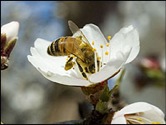![In Need of Bees!
In California there are hundreds of thousands of acres of almond trees. Each February they produce beautiful white blossoms. This is the signal that they are ready for pollination and are desperately in need of bees. In fact, almonds are not the only fruit that are dependent upon bees for pollination. One of every three bites of food that you eat comes through the work of insect pollinators. And the honeybee is one of the most important pollinators. Crops like almonds, squash, pears, pumpkins, soybeans, cucumbers, melons, broccoli, cauliflower, blueberries, apples, cherries, and more all need bees. In fact, over 100 crops in the U.S. need bees, The bee moves pollen from the male and female flower organs. This lets the plant produce seeds and then fruit. Without them there would be a food shortage.[2]
What Is the Problem?
1. Almonds are only fertile for 10-20 days a year around February and must be cross pollinated from tree to tree. This time of year can be cold, windy, or rainy. Bees don’t like to go out under any of these conditions. Less bees going out, less almond crop, less profit.
2. The bee population has been steadily decreasing for 50 years. Hives have to be shipped in from farther away because there are less hives,
3. Mites have caused 98% of the wild bees to die off. [24]
4. Loss of wild habitat around orchards means less natural honeybees.
5. Bees are easily injured by the use of chemical sprays.
6. Thousands of beehives are lost for unknown reasons.
7. Bringing bees from other states and countries cause environmental problems. It takes fossil fuels to transport bees. Pests like beetles and fire ants may come along with the hives. Diseases may be transmitted.](The%20Problem_files/shapeimage_1.png)


The Problem:
Pollinating Almond Trees

Where Have All the Bees Gone?
Since 1950 the bee population has decreased about 50 percent and is still declining. This is due to pests, pesticides, diseases, and loss of natural habitat. Honeybees are very sensitive to chemicals like pesticides and herbicides. These chemicals make the bees very angry and they can even kill them. One pest that really hurts bees is the parasitic mite. They attack bees. The use of pesticides has caused stronger strains of parasitic mites. These stronger mites have harmed the bee population, Also, in 2005 over 250,000 bee hives in California were lost for unknown reasons.
On the other hand, the demand for almonds is increasing. Over 1.5 million tones of almonds are produced in the world on average each year. The United States is the largest producer of almonds and California grows most of those almonds. Almonds are California’s 6th largest crop and the top agricultural export valued at over 1 billion dollars in 2003. The loss of natural habitats that used to surround the orchards and farms, has caused wild bees to decrease in numbers. This causes the need for commercial beehives. Beekeepers charge almond growers about $100 per hive for pollination services. It takes 1.4 million colonies of bees to pollinate the almond orchards just in California. That is half of all the commercial beehives in the U.S. and around 50 billion individual bees. This is the largest managed pollination in the world. The bees come from 38 different states and some even come from foreign countries like Australia.[13]



Honeybee Pollinating an Almond Blossom




